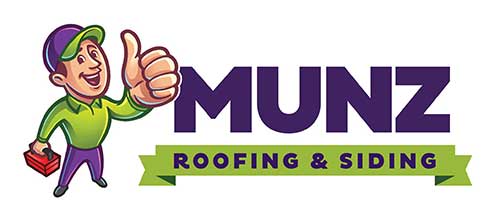After a storm, any damage to your roof should be taken seriously. It is important to check for any debris that may have been blown onto your roof and assess if there is any damage. Damage could include holes caused by flying debris, missing shingles or large branches falling on the roof. If you notice any of these signs, it’s best to call a professional like Munz Roofing right away who can provide you with an estimate for repair or replacement as needed.
When it comes to checking for storm damage on roofs, various factors come into play, especially for metal roofs. Hail damage is a common concern, requiring thorough inspection and potential roof repair. Roof truss repair may also be necessary if the structural integrity has been compromised.
Conducting a comprehensive roof inspection is crucial to assess the extent of damage. Engaging professional roofing contractors, particularly those affiliated with the National Roofing Contractors Association, is recommended for accurate assessments and minor roof repairs. Issues such as roof valley repair, roof leak repair, or dealing with a leaking roof should be promptly addressed to prevent further damage and mitigate potential costs. In severe cases, roof replacement costs may arise, particularly if the damage is extensive. Additionally, sagging roof repair costs should be factored in if the storm has caused significant structural damage.
Timely repairs can help reduce long-term costs associated with structural issues due to weather events such as storms. Additionally, Munz Roofing can provide advice and tips on how best to protect your property from further harm in the future – including regular maintenance checks and roof coating to reduce the risk of damage from storms and other elements. Protecting your home’s exterior surfaces is an important part of ensuring that your property remains safe and secure. Contact Munz Roofing today to learn more about how they can help protect your roof in the future!
Ten Ways You Can Check Your Roof For Damage After A Storm
1. Check for any loose shingles lying around the area – replace or repair them if found.
After a storm, one of the most important things to do is check for any loose shingles that may have been blown away or damaged. Loose shingles can be an indication of further damage and should be replaced or repaired as soon as possible. Shingle damage can be caused by high winds, hail, heavy rain, and debris flying from other structures.
Not only can loose shingles create a weak spot on your roof and cause leaks, but they can also allow water to get under the edge of shingles that remain in place, leading to water damage. In extreme cases, improper sealing of these edges can lead to structural problems with your roof. Properly replacing and repairing these shingles is key to properly protecting your home from future weather events or more serious roof issues like rot or mold. Make sure you contact a reputable roofer like Munz Roofing who has the experience and knowledge needed to properly replace and repair your roof’s shingles.
2. Inspect gutters and downspouts for debris that may have been sent flying during the storm.
Gutters and downspouts can be especially vulnerable to damage from storms as their surfaces are exposed to flying debris that can easily become lodged in the narrow channels. In addition, if there is debris clogging the gutters or downspouts, it can impair water flow causing it to back up onto your roof and find its way into the sides of your home.
After stormy weather, it’s important to inspect these areas for any debris that may have been sent flying during the storm, as this could create further damage. Cleaning out the gutters and downspouts should be done regularly regardless of weather conditions, but after a storm they should be carefully checked for any additional debris that could have caused clogs or damage. Make sure you contact a professional like Munz Roofing who has experience in working with gutter and downspout repair and who knows how best to prevent further damage caused by storms.
3. Look for cracked, curled, or missing shingles on your roof surface, as well as any visible damage to structure and flashing.
After a storm, it is important to always inspect your roof for any damage that may have occurred during the event. Look for cracked, curled, or missing shingles on your roof surface, which can indicate that there is more serious damage underneath and should be fixed as soon as possible.
Additionally, you should check for any visible signs of damage to the structure and flashing of your roof, which could include dents or cracks in these components. Having a professional assess the situation is always recommended if you notice any signs of potential damage. Flashing issues can be especially dangerous as they can lead to water entering the home and causing extensive interior damage over time. Munz Roofing is experienced in repairing all types of flashing and structural issues that may arise from storms and other weather events – contact them today to get an assessment of your home’s roof!
4. Examine the roof’s ridge cap and valleys to look for signs of wind shear or seismic activity from the storm.
It is important to check the roof’s ridge cap and valleys for any signs of wind shear or seismic activity as a result of the storm. Wind shear can be defined as a sudden, intense change in wind speed and/or direction, often associated with thunderstorms.
If your roof has been exposed to strong winds during a storm, it is possible that it could cause damage to the ridge cap or valley areas. It is important to inspect these areas for signs of shifting or displacement that could indicate wind shear. Additionally, seismic activity such as tremors and earthquakes can also cause damage to a roof’s ridge cap and valleys. Any shifts in this area should be checked out by a professional like Munz Roofing as soon as possible in order to repair any damage that may have occurred due to seismic events.
To properly protect your home from further harm, they will recommend regular inspections and maintenance checks as well as applying protective coatings on the roofing material to reduce the risk of significant weather-related damage over time.
5. Take a closer look at chimneys, vents, exhaust pipes, and other roof protrusions to check for deterioration or separation caused by extreme wind gusts or hailstone bombardment during the storm.
Chimneys, vents, exhaust pipes, and other roof protrusions can be particularly susceptible to damage caused by extreme wind gusts or hailstone bombardment during a storm. Due to their elevated positions on the roof, these structures are exposed to unpredictable and powerful winds that can cause damage in the form of cracking, shifting, or deterioration of the material.
In addition, hailstone bombardment can also cause substantial damage to these structures over time. Regularly inspecting these areas for any signs of deterioration or separation is important in order to spot potential issues early on and make necessary repairs or replacements as soon as possible. Severe weather events such as storms can often cause damage that is not immediately visible but could lead to much more serious structural issues if not addressed quickly. It is best to contact a professional like Munz Roofing who has experience in dealing with issues related to roofs damaged by storms.
Their team of skilled technicians will be able to inspect your home’s roof for any signs of deterioration or separation caused by wind gusts or hailstone bombardment during the storm and provide you with the best solution for repairing or replacing your roof in order to ensure it remains safe and secure for years to come.
6. Analyze fascia boards around the edges of your roofline for signs of damage that may have been caused by wind-borne debris during a stormy night.
Fascia boards are an important part of a roofline as they provide protection and support for the edge of the roof. During stormy nights, wind-borne debris can cause significant damage to these boards due to their elevated position on the roof.
To avoid more serious structural issues, it is important to regularly inspect fascia boards around the edges of your roofline for signs of damage that may have been caused by wind-borne debris during a storm. Signs of potential damage include dents or cracks in the boards, warping or displacement, and general deterioration due to exposure to extreme weather conditions. It is best to address any issues with fascia boards as soon as they are noticed in order to avoid further harm being done to the roofline.
For this reason, it is important to contact a professional like Munz Roofing who has experience in dealing with issues related to roofs damaged by storms. Their team will be able to inspect your home’s fascia boards for any signs of damage and provide you with the best solution for repairing or replacing them in order to ensure your home remains safe and secure for years to come.
7. Use binoculars to inspect from ground level if you can’t get up onto the roof yourself – this will help you find any obvious leaks which can be further investigated with a professional contractor when necessary.
Using binoculars to inspect your roof from ground level can help you spot any obvious signs of leaking or water damage. This is especially important if you are unable to get up onto the roof yourself. While it is still advisable to have a professional investigate these leaks in detail, binoculars can enable you to spot any potential issues before they become more serious and costly.
When using binoculars to inspect your roof, make sure to look for cracked shingles, discolored tiles, broken flashing, and other signs of water damage that may indicate leaks. Additionally, pay close attention to the areas around vents and chimneys as these can be particularly susceptible to water damage due to their elevated position on the roof. If you notice any signs of leakage, contact Munz Roofing as soon as possible for an assessment and repair solution in order to protect your home from further harm.
8. Investigate areas near skylights and window frames to inspect them for cracks or broken seals which could lead to future water leakage issues caused by storms’ strong winds and rain showers.
Skylights and window frames are vulnerable to storm damage due to their exposed nature. During strong winds and rain showers, these areas can be particularly susceptible to water leakage issues as cracks or broken seals can form. It is important to inspect these areas for any signs of cracking or breaking that could potentially lead to water leakage in the future.
Look for discoloration in the surrounding area which may indicate water damage, as well as any loose caulking along the edges of the window frame where it meets the siding or roofing material. Additionally, check for any warping or separation along the edges of windows and skylights that could have been caused by wind driven rain.
If you notice either of these issues, it is best to contact a professional like Munz Roofing as soon as possible in order to assess and fix the problem before further harm is done to your home’s exterior structure.
In addition, it is also important to inspect flashing around windows and skylight frames for any broken or worn out pieces that may have been torn off during strong wind gusts. Flashing plays an essential role in protecting your home from damaging moisture penetration so any noticeable wear or damage should be addressed immediately by a professional like Munz Roofing who has experience dealing with roof repair issues related to storms.
9. Look out for tree limbs or branches that have fallen onto your roof – these should be removed immediately as they could cause additional damage in time!
Tree limbs or branches that have been blown onto your roof during a storm should be removed immediately as they can cause additional damage over time. These can range from dents caused by the weight of the branch to punctures and tears in shingles, tiles, and other roofing materials due to sharp edges or protruding twigs.
Even if there is no visible damage at the time of impact, any debris left on your roof can heat up when exposed to direct sunlight and cause further harm to materials underneath it. Debris can also collect moisture which can lead to water infiltration, which in turn can cause more serious issues such as mold growth and structural instability.
Therefore, it is best to take action quickly and remove any tree limbs or branches that have been blown onto your roof after a storm in order to prevent any potential issues down the line. If you are unsure about how to address this issue safely and effectively, contact a professional like Munz Roofing who has experience dealing with storm-related roof repair issues.
Their team of experienced technicians will be able to remove debris from your roof quickly and efficiently while ensuring minimal disruption to your home’s exterior structure.




